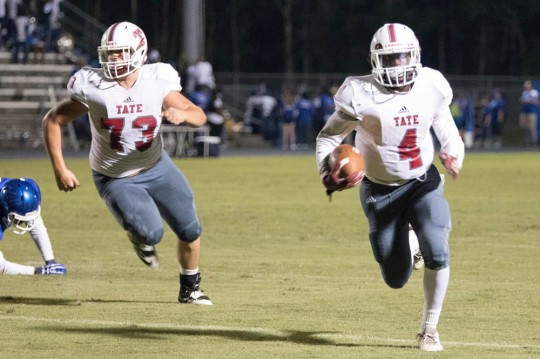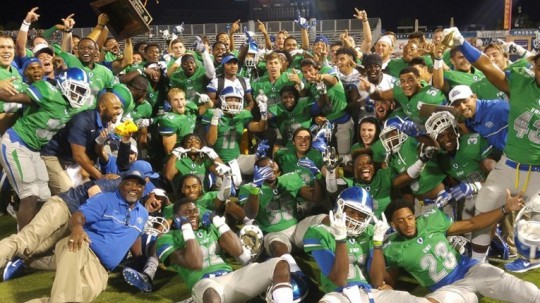FDOT Weekly Traffic Alerts: Hwy 29, Hwy 4, Nine Mile Road, I-10
October 3, 2016
Drivers will encounter traffic disruptions on the following state roads in Escambia and Santa Rosa counties as crews perform construction and maintenance activities.
Escambia County:
· S.R. 4 over Escambia River Bridge Maintenance- Intermittent lane restrictions over Escambia River, 1.5 miles east of U.S. 29 from 8 p.m. Monday, Oct. 3 to 5 a.m. Tuesday, Oct 4 as crews perform routine bridge maintenance work.
· S.R. 4 over East Relief Bridge Maintenance- Intermittent lane restrictions over East Relief, three miles east of U.S. 29, from 8 p.m. Tuesday, Oct. 4 to 5 a.m. Wednesday, Oct. 5 as crews perform routine bridge maintenance work.
· Bayfront Parkway (State Road (S.R.) 196) - Temporary road closure between Tarragona Street and 9th Avenue from 8 a.m. to 11 p.m. Friday, Sept. 30 through Sunday, Oct. 2 for the Pensacola Seafood Festival. A signed detour route will be in place to assist drivers.
· Interstate 10 (I-10) / U.S. 29 Interchange Improvements Phase 1 – The inside lanes of U.S. 29 north and southbound near the I-10 interchange will be closed from 8 p.m. to 6 a.m. Sunday, Oct. 2 through Thursday, Oct. 6 for drainage improvements.
· 9 Mile Road (from Pine Forest Road to U.S. 29) Widening – Lane restrictions near the intersection of 9 Mile and Pine Forest roads Tuesday, Oct. 4 as crews continue clearing trees and shrubs. Eastbound traffic will be shifted into the westbound turn lane onto southbound Pine Forest Road. Drivers may also encounter brief intermittent stops as crews remove debris along the roadway. Lane closures are only permitted between the hours of 8 p.m. and 6 a.m.
· 9 Mile Road (from Beulah Road to Pine Forest Road) - Clearing of trees and shrubs on the 4.8-mile segment has begun. Lane closures are only permitted between the hours of 8 p.m. and 6 a.m.
· U.S. 29 (from I-10 to 9 Mile Road) Widening – Crews have begun clearing operations for pond locations. Motorists will see activity in relation to this near the intersection of Ryan Avenue and Detroit Boulevard. Lane closures will only be permitted between 8 p.m. and 6 a.m.
· I-10 (from Davis Highway to Scenic Highway) Widening – Northbound Scenic Highway (U.S. 90) traffic has been shifted to the newly constructed northbound travel lanes. The shift allows crews to install the concrete traffic separator in the median between the north and southbound lanes and open the park and ride facility.
Santa Rosa County:
· I-10 Widening – Alternating lane closures, between the Escambia Bay Bridge and S.R. 281 (Avalon Boulevard/Exit 22), from 8 p.m. to 6 a.m. Sunday, Oct. 2 through Thursday, Oct. 6 as crews continue widening work. In addition, there will be alternating lane closures on Avalon Boulevard near the I-10 interchange for bridge work.
· I-10 Resurfacing – Intermittent and alternating lane closures east and westbound between the S.R. 87 interchange and the Okaloosa County line from 8 p.m. to 6 a.m. Sunday, Oct. 2 through Friday, Oct. 7 as crews perform construction activities. Motorists are reminded the speed limit is reduced to 60 MPH within the lane closure.
All activities are weather dependent and may be delayed or re-scheduled in the event of inclement weather. Drivers are reminded to use caution, especially at night, when traveling in a work zone and to watch for construction workers and equipment entering and exiting the roadway.
Traffic on State Road 4 at the Escambia River Bridge in Century may encounter lane restrictions. NorthEscambia.com file photo.
Scott Quietly Shifts Court Rightward
October 3, 2016
It was a simple, two-paragraph letter from Judge Robert Benton II to Gov. Rick Scott a little more than a year ago that marked a milestone in Benton’s life and in the course of one of the most important courts in Florida.
“God willing,” Benton wrote at the end, “on January 16, 2016, I will attain the age of seventy years and so become ineligible … to continue to serve as a judge, except upon temporary assignment.”
And with that, the last Democratic appointee on Florida’s 1st District Court of Appeal — who was appointed to the court by Gov. Lawton Chiles in 1994 — set in motion the process for a Republican governor to select his successor.
For that successor, Scott turned to Allen Winsor, the solicitor general for Attorney General Pam Bondi. If the 39-year-old Winsor serves until the mandatory retirement age that Benton reached, he will have spent three decades on the bench.
 As speculation turns to Scott’s first Florida Supreme Court appointment, with the upcoming retirement of Justice James E.C. Perry, a more dramatic makeover of the state’s judiciary system has gone almost unnoticed. All of the state’s five district courts of appeal now have Republican-appointed majorities. Three have benches that are entirely comprised of judges named by governors who were elected as Republicans. (Gov. Charlie Crist appointed Judge Kevin Emas to the 3rd District Court of Appeal after bolting the GOP late in his term.)
As speculation turns to Scott’s first Florida Supreme Court appointment, with the upcoming retirement of Justice James E.C. Perry, a more dramatic makeover of the state’s judiciary system has gone almost unnoticed. All of the state’s five district courts of appeal now have Republican-appointed majorities. Three have benches that are entirely comprised of judges named by governors who were elected as Republicans. (Gov. Charlie Crist appointed Judge Kevin Emas to the 3rd District Court of Appeal after bolting the GOP late in his term.)
Scott alone has appointed nine of the 15 judges on the 1st District Court of Appeal, which is based in Tallahassee and hears most of the cases challenging the authority of the governor and the Legislature.
And with his choices, Scott has at times overtly attempted to shape a more conservative bench — aided, critics say, by changes to the process for naming judges approved during Gov. Jeb Bush’s time in office — and will leave a judicial legacy that far outlasts his tenure. Even if Perry’s replacement is the only justice the current governor installs on the Supreme Court, Scott’s legal legacy could be in place for a generation.
‘THE RULE OF LAW’
It was, perhaps, a rookie mistake. In February 2011, a little more than a month after he had been sworn in as governor, Scott made his first appeals-court appointment. He tapped Burton Conner to serve on the 4th District Court of Appeal, which includes Broward, Indian River, Martin, Okeechobee, Palm Beach and St. Lucie counties.
“Judge Conner represents the values and judicial conservatism I am looking for in our judges,” Scott said in a statement announcing the appointment. “He has a great reputation in the community and a great law-and-order demeanor. Primarily a criminal court judge for most of the past 15 years, he has demonstrated a judicial philosophy that makes him unlikely to overstep the role of the judiciary.”
Some in the legal community were taken aback by Scott’s explanation for why he chose Conner.
“What it says to me is, the governor has an agenda with judges. It’s unsettling,” former Judge Gary Farmer, whose exit created the vacancy, told The Palm Beach Post. Farmer’s criticism was not about Conner, whom he recommended, but Scott’s mentioning the new judge’s political bent.
Scott would rarely again so bluntly link his judicial appointments to a particular philosophy. But he would use phrases popular in conservative legal circles, referring again and again to “the rule of law,” judicial restraint and a judge understanding the proper role of the branches of government.
For example, in 10 of the 22 statements about judicial appointments following Conner that can still be found on Scott’s website, the governor uses the phrase “rule of law” in lauding his choice.
Few attorneys, especially those who go before appellate courts, are willing to publicly discuss the political leanings of judges. But some, particularly among those whose areas of expertise might not be in favor with the current governor, privately concede that there has been a shift in the direction of the district courts of appeal, some of it preceding Scott.
Those attorneys’ complaints sometimes come around to the Federalist Society, a prominent conservative legal group that formed in the 1980s. The Federalist Society mentions “the rule of law” in its statement of purpose. The group also believes judges should “say what the law is, not what it should be” — an almost verbatim echo of Scott’s comment in 2011 about 1st District Court of Appeal Judge Stephanie Ray, who Scott described as committed to making sure “judges say what the law is, rather than what it should be.”
Six of the judges Scott has named to appellate courts since taking office either list themselves as members of the Federalist Society or have been on the agenda to appear before one of the first two annual conferences of the Florida chapters of the society. Two of the rumored names for Scott’s choice on the Supreme Court — 5th District Court of Appeal Judge Wendy Berger and attorney Dan Gerber — have appeared at one of those events.
There are also suggestions that Scott only appoints certain kinds of attorneys or judges to the appellate courts. Attorneys for plaintiffs, particularly those in personal-injury cases that many Republicans scorn, have come to believe that it’s pointless to apply for appellate-court positions or spots on the panels that nominate judges.
The courts now also feature fewer lawyers who have represented individual clients, critics say, and more who were prosecutors and government lawyers, or represented institutions or corporations at large law firms.
That can be as much or even more of an issue than the political balance of the courts, lawyers say, because it has more far-reaching effects than the few, highly publicized blockbuster cases on polarizing issues.
RULES OF THE GAME
Scott would hardly be the first chief executive to try to install judges with similar judicial philosophies to his own, nor would he be the first to fill the courts with young appointees. The last of the Supreme Court justices chosen by Chiles, who died near the end of his term in 1998, won’t rotate off the bench until 2018.
However, the power of Scott, Crist and Bush to shape the courts has been enhanced by a change made to the selection process during Bush’s tenure. That measure reshaped the judicial nominating commissions responsible for forwarding potential nominees to the governor.
Initially, under the “merit retention” system that Florida adopted after a series of scandals rocked the Supreme Court in the 1970s, the governor chose three members of each judicial nominating commission. The Florida Bar chose three more and an additional three members were chosen by those appointees.
After the Bush-era changes, though, the governor essentially names all nine members of the nominating commissions — five of his choice, and four from lists submitted by The Florida Bar.
“Now, we’re getting younger people (appointed as judges) who have more of a political philosophy than those who went up on merit,” said Greg Barnhart, of the law firm Searcy, Denney, Scarola, Barnhart & Shipley.
The 22 judges whose ages were listed in Scott’s appointment announcements were, on average, just past their 49th birthday when Scott installed them on the bench. That would allow them to serve for almost 21 years before reaching age 70. At 39, Winsor was the youngest.
Others are less certain that damage has been done by the changes to the judicial nominating commissions. Drew Lanier, a political-science professor at the University of Central Florida, co-wrote a journal article in 2001 arguing that under Bush’s change, “the independence of the state’s judiciary has been implicitly whittled down.”
Now, he’s more sanguine, despite ongoing attempts by the Legislature to change how the judiciary is chosen.
“Nonetheless, I think the courts have stood pretty independent from those forces,” Lanier said.
Dorothy Easley, a past chair of the Appellate Practice Section of The Florida Bar, said most judges at the appellate courts appear to be making decisions based on the law, not the governor who appoints them.
“The real issue is whether qualified jurists are being appointed by this governor, and whether I agree or disagree with his politics, I think the answer is ‘yes,’ ” Easley said.
THE LAST HOLDOUT
One court has so far remained out of reach for Scott and other Republicans: the highest one in the state. But the twilight hour for a relatively liberal majority could be fading in that court as well.
Perry was one of the justices who make up that 5-2 majority, though individual members of the majority sometimes join the court’s two conservatives. Three more justices are set to retire at the end of 2018 — R. Fred Lewis, Barbara Pariente and Peggy Quince. All three are members of the majority on many divided cases.
Quince was a joint appointment, of sorts, between Bush and Chiles in the waning days of the Democrat’s time as governor. In 2006, the Supreme Court issued an advisory opinion saying that the judicial nominating process can begin under the old governor even though a vacancy doesn’t technically occur until the outgoing justice’s term expires. Lewis, Pariente and Quince’s terms will expire on the same day a new governor takes office in January 2019.
Saying the situation was still ambiguous, Republicans pushed a proposed constitutional amendment in 2014 that would have allowed the outgoing governor to pick replacement in such situations. It was defeated. That could lead to another conflict in 2018 if Scott decides to press the issue and seek to make the appointments.
In the meantime, the Supreme Court has repeatedly pushed back against measures approved by Scott and the Legislature, now often doing so by reversing decisions reached by appellate courts. The Supreme Court repeatedly rebuked the Legislature’s redistricting plans following the 2010 U.S. Census, leading to sweeping changes in the districts for Florida’s congressional delegation and the state Senate. But Scott and the Legislature have also won favorable rulings on issues like a change that required state employees to pay into their own retirement plans — contrary to a trial court’s ruling in that case.
Scott has laid out only general principles so far in what will guide him in his decision-making about appointing a successor to Perry.
“If you talk to any judges that I’ve appointed, that I’ve interviewed, I generally care about two things. Are they going to be humble in the process, and are they going to uphold the law. That’s what I care about. I want people that want to uphold our existing laws,” he said. “I get to sign or veto bills. I don’t pass laws. I expect our court system to uphold the laws of our state.”
Barnhart said the proof will be in who Scott names. The conservative members of the current court have been respected legal minds, he said. But a young nominee with connections would send a different message.
Lanier said the current court was acting independently, balancing rulings against the GOP majority in some areas with others in its favor. He conceded that Scott’s upcoming appointment gives the governor the opportunity to alter that balance slightly.
“He’s not going to change it all that much,” Lanier said.
by The News Service of Florida
Bonus Gallery: Tate Beats Washington
October 3, 2016
For a photo gallery from Friday night’s Tate defeats Washington game, click here.
NorthEscambia.com photos by Jennifer Repine, click to enlarge.
Bonus Gallery: Northview Football
October 3, 2016
For a photo gallery from Friday night’s Northview at Maplesville, AL, game, click here.
NorthEscambia.com photos by Gary Amerson, click to enlarge.
Vendors Needed For Century Chamber Fall Festival
October 3, 2016
The Century Area Chamber of Commerce is planning a Fall & Craft Festival & Car Show for Saturday, October 15 at Showalter Park.
The event will feature craft booths, family fun, food, a car show and entertainment featuring The Horseshoe Halo Band and Michael Peterson.
The chamber is currently seeking vendors, entertainment and sponsors for the event. For a vendor booth application, click here. For sponsorship or other information, call Kim at (850) 256-3208 or email kgodwin@centuryflorida.us.
The festival is sponsored in part by NorthEscambia.com.
Pictured: NorthEscambia.com file photo, click to enlarge.
Thousands Attend Jay Peanut Festival (With Photo Gallery)
October 2, 2016
The 27th annual Jay Peanut Festival attracted thousands of people this past weekend.
 The Jay Peanut Festival at the Gabbert Farm has been a fall tradition on the Gulf Coast, showcasing the history, agriculture, food and fun of Santa Rosa County. What started as a chance for local kids and farmers to show off their best of the season has become an annual event covering 15 acres and drawing about 70,000 people to the Gabbert farm over two days.
The Jay Peanut Festival at the Gabbert Farm has been a fall tradition on the Gulf Coast, showcasing the history, agriculture, food and fun of Santa Rosa County. What started as a chance for local kids and farmers to show off their best of the season has become an annual event covering 15 acres and drawing about 70,000 people to the Gabbert farm over two days.
The event included tours of the 1930s Farm Museum, food booths, dozens of arts and crafts vendors, pony rides, games and fun. The Jay Peanut Festival was also a chance to try all varieties of peanuts – boiled, green, fried, candied and more.
The Gabbert farm is located at 3604 Pine Level Road.
For a photo gallery, click here.
NorthEscambia.com photos by Marcella Wilson, click to enlarge.
UWF Takes Down #16 Florida Tech In Inaugural Coastal Classic
October 2, 2016
The UWF football team scored 21 unanswered points and held of a late rally to upset No. 16/19 Florida Tech, 42-39, before a sold-out crowd of 6,588 at Blue Wahoos Stadium Saturday.
UWF (3-2, 1-1 Gulf South Conference) collected 458 yards of total offense and 360 through the air in claiming the inaugural Coastal Classic, which pitted the only Division II football programs in the state of Florida.
The Argonauts scored 21 points in each half against the Panthers, who entered the game ranked second in the country, yielding just 8.8 points per game. Additionally, UWF collected three red zone scores against an FIT group that had allowed just three successful efforts all season.
Kaleb Nobles was 23-of-42 with a 74-yard touchdown pass to Caleb Robinson. Nobles also ran for a score for the second-consecutive week. Grey Jackson was 1-for-4 and completed a 65-yard scoring strike to Ishmel Morrow in the second quarter that gave the Argonauts the lead for good.
Morrow finished with 129 yards on seven catches. It was his third-straight 100-plus yard game. Anas Hasic added 60 yards on three receptions.
Florida Tech (4-1, 2-1) grabbed the early 7-0 lead when Trevor Sand scored from seven yards out just over three minutes into game. The short field came about after UWF fumbled at its own 35-yard line on its first play from scrimmage.
Jemari Ford tied the game on UWF’s next possession with a 2-yard rush. The Argonauts went up 14-7 on the long Jackson-to-Morrow play, before taking a 21-7 lead into the locker room following Leroy Taylor’s 17-yard interception return for a touchdown.
Coming out of the intermission, the Panthers trimmed the margin to 21-17 with a field goal and 12-yard scoring pass. The teams traded scores before UWF made it a 2-possession game on the Nobles-to-Robinson connection.
FIT wouldn’t go away, scoring twice in a span of 1:48 before UWF held off a late push to midfield to claim its first-ever win over a ranked opponent.
UWF will hit the road next week when it faces Mississippi College on Saturday, Oct. 8 in Clinton, Miss. Kickoff at Robinson-Hale Stadium is set for 2:00 p.m.
Special Commission Meeting To Address New County Jail
October 2, 2016
A special Escambia County Board of County Commissioners meeting has been scheduled for Wednesday, October 19 at 9 a.m. to discuss the new county correctional facility. The meeting will be held in the Board Chambers, Room 100, in the Ernie Lee Magaha Government Building, 221 Palafox Place in Pensacola.
DLR Group Inc., was selected by the board of county commissioners to be their design criteria professional for the new correctional facility. DLR Group’s scope of services is to prepare the design criteria package for a design-build entity, to design and construct the new facility and to serve as the owner’s representative during the construction and transition into this new facility. County staff and the DLR Group will be giving a presentation to the board addressing the status of the property acquisition, discussions of the design-build process, the design criteria professional’s phases and scope of services, the current project status and steps moving forward. Additional topics may be discussed at the board’s discretion.
This meeting can be viewed live on MyEscambia.com/ectv, channel 98 for Bright House, Cox Cable and Mediacom (Pensacola Beach) subscribers and channel 99 for AT&T U-verse subscribers and will be available on ECTV On Demand.
Pro-Pot Group Gets $1 Million Boost In Legalized Marijuana Fight
October 2, 2016
Proponents of a constitutional amendment that would broadly legalize medical marijuana in Florida received a $1 million boost this week from a political committee focused on similar initiatives in other states.
The committee, New Approach, is tied to the family of the late philanthropist Peter Lewis, the former head of Progressive Insurance who died in 2013 and who bankrolled medical-marijuana proposals in Washington and Massachusetts. New Approach also was a major contributor to an Oregon initiative that legalized recreational marijuana in 2014.
 It’s the largest single contribution received by supporters of Amendment 2 and comes as the battle over the constitutional question heats up in advance of the Nov. 8 election. As another sign of the growing battle, a powerful state senator and a former Florida Supreme Court justice appeared at a news conference Friday to oppose the ballot initiative.
It’s the largest single contribution received by supporters of Amendment 2 and comes as the battle over the constitutional question heats up in advance of the Nov. 8 election. As another sign of the growing battle, a powerful state senator and a former Florida Supreme Court justice appeared at a news conference Friday to oppose the ballot initiative.
“We are obviously very pleased to receive such a generous donation (from New Approach). It’s going to be put to good use very quickly, making sure that our message is on television across the state and that Floridians understand this is about putting medical decisions back in the hands of doctors and patients and out of the hands of politicians,” said Ben Pollara, campaign manager of People United for Medical Marijuana, also known as United for Care.
Pollara is hoping to parlay the contribution from New Approach into more financial support.
“It’s going to be a big acknowledgment to our existing donor base of 8,000 people that we’re almost to the finish line and we’re getting substantial support. I think it will be a huge boon for our fundraising,” Pollara said Friday.
Orlando trial lawyer John Morgan and his law firm have been the major financial backers of Amendment 2, which mirrors a similar proposal that voters narrowly rejected two years ago. So far this year, Morgan and his firm have contributed more than $2.6 million to People United for Medical Marijuana, which he also chairs.
Morgan is also paying for radio ads running statewide urging voters to support the amendment. Exactly how much he has spent on the ads has not yet been reported, and Morgan said he doesn’t know what the total will be.
“I’m spending a fortune right now,” Morgan said in a telephone interview Thursday evening. “I don’t know what the number will be until the month’s over. I’ve done a dangerous thing — I’ve given a blank check to the radio stations.”
This week’s contribution from New Approach came as the Drug Free Florida Committee — which played a key role in defeating the 2014 amendment — spent more than $1.8 million during the first three weeks of September to fight the initiative, with most of the money going to advertising.
Las Vegas casino tycoon Sheldon Adelson contributed $1 million this month to the Drug Free Florida Committee, which also received $800,000 in July from the Carol Jenkins Barnett Family Trust. The trust, associated with the daughter of Publix Super Markets founder George Jenkins, also contributed $540,000 in 2014 to the Drug Free Florida Committee.
Tampa Bay developer Mel Sembler has also contributed $1 million this year to try to defeat the proposal. Developer Al Hoffman also contributed $25,000 to oppose the amendment.
On Friday, state Sen. Jack Latvala, a Clearwater Republican who opposes the amendment, told reporters he was underwriting a television ad in the Tampa Bay area urging his constituents to vote “no” on the ballot proposal. Latvala, the incoming Senate appropriations chairman, appeared at a news conference in Tallahassee with former Florida Supreme Court Justice Kenneth Bell.
Latvala, who estimated the cost of the ad at about $100,000, acknowledged that recent polls have showed Florida voters overwhelmingly back legalizing medical marijuana.
“My position is probably upside down at this point,” he said.
Latvala two years ago opposed a measure that legalized non-euphoric medical marijuana for people with chronic muscle spasms, epilepsy or cancer. That law, which was expanded this year to include full-strength marijuana for terminally ill patients, was aimed at helping children with severe forms of epilepsy. Parents argued the low-THC treatment can dramatically reduce or eliminate life-threatening seizures.
“I have seen the effects that marijuana has on individuals,” Latvala said. “I’m a moderate on many issues. … But not on this one.”
Five weeks before the general election, Amendment 2 has received less attention than the marijuana issue got during the 2014 election season.
One of the highest-profile opponents of the 2014 measure — the Florida Sheriffs Association — has stayed on the sidelines thus far, opting not to take a position on the revamped proposal.
Two years ago, Morgan used a bus tour to promote the marijuana initiative to college students.
In one of many appearances across the state, the Orlando lawyer was caught on tape delivering a boozy, expletive-laced monologue to what appears to be a crowd of young supporters at a bar after a rally in the Lakeland area.
“I’ve decided that less of me is more. I want the focus to be on the issue, not on me,” Morgan said of this year’s campaign.
Cantonment Woman Cited After Serious Injury Crash
October 2, 2016
A Cantonment woman was cited by the Florida Highway Patrol for causing a wreck about 8 p.m. Saturday on Blue Angel Parkway at Saltillo Street in Escambia County.
According to the FHP, 36-year old Janet Orth of Cantonment was northbound on Blue Angel Parkway in a 2011 Kia Forte when she was distracted by “an internal distraction in the vehicle” and drifted into oncoming traffic. Her vehicle collided with a 2000 Jeep Cherokee driven by 61-year old Nancy Thompson of Lillian. The Jeep overturned into the path of a 2016 Chrysler 200 driven by 26-year old Samantha Dyson of Cantonment.
Thompson and her passenger, 65-year old Richard Miller of Lillian, were trapped in the Jeep before be extricated by Escambia Fire Rescue. Thompson was transported to Baptist Hospital as a trauma alert, while Miller was transported to Baptist with minor injuries. Dyson was also transported to Baptist with minor injuries.
Orth received minor injuries but was not taken to the hospital. She was cited for failure to drive in the proper lane by the FHP.
Courtesy photos for NorthEscambia.com, click to enlarge.













